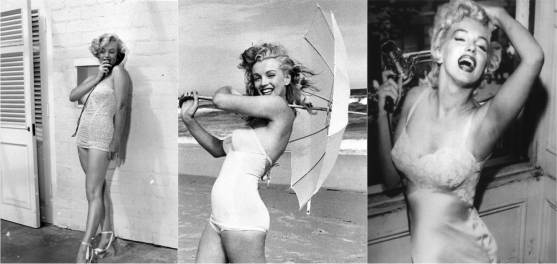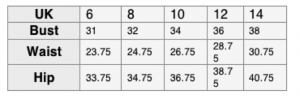When you look at these pictures, a lot of words probably spring to mind. Curvy – yes, feminine – yes, sexually sexual – YES… but a size 16? Not from where I’m looking…
There has been a myth circulating for a long time that Marilyn Monroe was what we know today as a UK size 14-16. I think it was one of my favourite blogs, Scouse Bird Problems, that first made me aware of what a misconception that actually was. Digging a little further, I found that there was indeed no way that Marilyn was the same as a size 16 today. As this article explains, her dressmaker had her measurements listed as 35-22-35 (bust-waist-hips). Those are definitely not the measurements of many size 16s that I see on the high street today. So why do people make this claim? Is it just because she was curvy, and people have blown the truth out of proportion?
Well it seems like the answer might be that she did wear a 14 or 16 in US sizes – at the time.
I wouldn’t usually cite Wikipedia as a source but SO WHAT I’M NOT IN UNI NOW, SCREW YOU HARVARD REFERENCING (Cavanagh, C., 2013). But yes, in this Wikipedia article on the subject of vanity sizing, it states the case of Sears’ department store in America. Apparently, a dress with the same measurements – 32 inches around the bust – was initially sold as a size 14 in 1937. The dress with the same measurements was then being sold as a size 8 in 1967, and eventually was branded as a size 0 in 2011. This is obviously an extreme case, but it highlights the trend of ‘vanity sizing’ that’s received quite a bit of press over the last few years. Vanity sizing refers to the effort that retailers go to to flatter their customers with more generous sizing – meaning that they will fit into size 8 clothes when they’re usually a 10 or 12, for example.
I’m sure that shops and brands using different size guides is something we’re all familiar with – it explains why I personally have clothes of three different sizes in my wardrobe. Their thought process, I’m guessing, is that you’re likely to re-visit a shop if you take a size 8 in there, as opposed to the shop down the road where you take a 12. I can see their logic – however much you know that your health and weight are about how you feel, there’s always that bit of a buzz when you fit into a smaller size.
But do the retailers think about the negatives associated with vanity sizing? Not only does it make the whole shopping process ten times more of a faff (‘could you just get me these in every size from a 6 to a 14 please, and cancel all of my social commitments for the next three days while I try them on, cheers ’), but also for some girls it’s really disheartening to not fit into the ‘right’ size in some shops. Of course, sizes can depend on a number of things – sometimes we like things in a baggier fit, sometimes you might size down if you’re short and want it to fit better. But it does seem ridiculous – and a bit patronizing – for the UK high street to be trying to trick us into feeling skinnier.
So, which shops are playing by the rules and which are throwing digits round as randomly as a girl at a bar trying to fake-number (‘fumber’) some drunk man chatting her up?
Here, according to my trusty friend Wikipedia, is the UK standard sizing guide, though the article states that this is regularly deviated from.
As you can see, our gorgeous Marilyn with her 35-22-35 measurements had the waist of someone well under a size 6. Her curves obviously made her bigger than this, but basically she would have been likely to still fit into a size 10 pair of jeans.
To see how the UK high street matches up to the standards, here are the sizing guides of a selection of our favourite shops. I’ve separated sizes 6 and 8 as this is what the retailers do, though it’s interesting that the standard regards them as the same.
(Sorry for only including the sizes up to a 14 – I had to make these snazzy tables myself and frankly it was all too numerical for me. I struggled in a way that would make my GCSE maths teacher weep.)
I hope this can give you a rough idea of how much sizes differ in just a small sample of high street shops. Here are some of the main things I noticed:
• I always thought Topshop and Asos both came up a bit big in their sizings, but it seems they actually both stick quite closely to the UK standard.
• Asos allows for almost an extra inch on the hips than Topshop do. They’re pretty much the standard, so Topshop actually come up a little small.
• H&M’s sizes are significantly smaller than the standard, particularly in their bust measurements. By the time you get to a size 14 in H&M, the bust is 2” smaller than Topshop, Asos and the standard. This seems to be almost anti-vanity sizing – are they determined to make us all feel fat? Or do they only want the teeniest tiny girls?
• River Island is MUCH more forgiving in all measurements, and are definitely the worst case of vanity sizing in this list. They’re usually only out by an inch or two, but we all know that that extra inch can make a big difference.
What do you all think of vanity sizing – do you hate it, or do you just accept it as a normal part of shopping? How have you found these shops mentioned, and are there any others that you think are particularly bad for sizing too big or small? Would love to know your opinions on it!






